Ironic, folkloristic, playful, engaging—the images of Nicola Tripodi’s terracotta sculptures jumped out of the computer screen as I scrolled through my Facebook timeline. “Like,” most definitely. I have pondered, reacted to and shared numerous of the artist’s works, and this past week decided it was high time to view them in person at his studio and shop, ARGHILLÀ l’arte delle terre in Reggio Calabria, located in the very south of Italy.
ARGHILLÀ L’ARTE DELLE TERRE
For Nicola Tripodi, Arghillà is a symbolic place where memory and culture of an ancient land take form. This terra is Calabria, his home. His arte delle terre is an art born of the lands that have given fruit to a rich culture and humanity, even of a four-legged variety at times.
Growing up in Reggio Calabria, Nicola reminisces of playing in the city’s fiumara, riverbeds that are dry for much of the year, where he came across clay and the joy of shaping the malleable substance into various forms. This memory and the desire to work with clay remained with him throughout his life, although he studied scenografia (stage design) at the Accademia di belle arti in Reggio and for many years engaged in a career as a graphic designer.
However, in the year 2000, Nicola Tripodi took the leap to follow his dream and set up his shop, Arghillà l’arte delle terre, in a nondescript neighborhood just south of Reggio’s historic center.
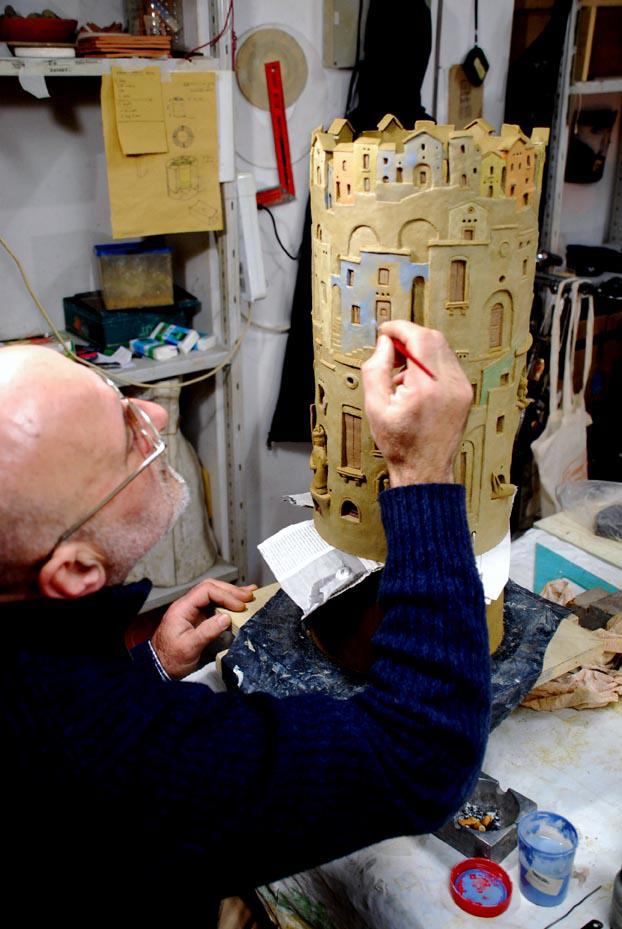
Nicola Tripodi, artist ARGHILLÀ l’arte delle terre, working on a nativity scene
TERRACOTTA STUDIO IN REGGIO CALABRIA
Driving down Via Sbarre Centrali and looking for number 249, the somewhat hectic, narrow road appeared an unlikely place for an artist’s studio. The storefront would have seemed more appropriate on Reggio’s tonier Corso Garibaldi, the central, pedestrian-only shopping street lined with majestic edifices in stile Liberty (art nouveau). Nicola smiled as he told of a pair of old women peeping into the shop when it first opened, not seeing him on the other side of the glass. The objects weren’t to their taste, and they were sure the enterprise wouldn’t make it.
He would like to have a shop in a neighborhood with more foot traffic, where people stopped by for a chat, and magari (if only), with a view of the sea or mountains. Locals and their natural environment play important roles in his work.
The space isn’t large, a nicely appointed gallery with an open laboratorio (studio) just behind. He and his familial assistants were concentrated, busy at work when I arrived. Nicola came out to meet me. He’s a gentle soul, soft-spoken and thoughtful.
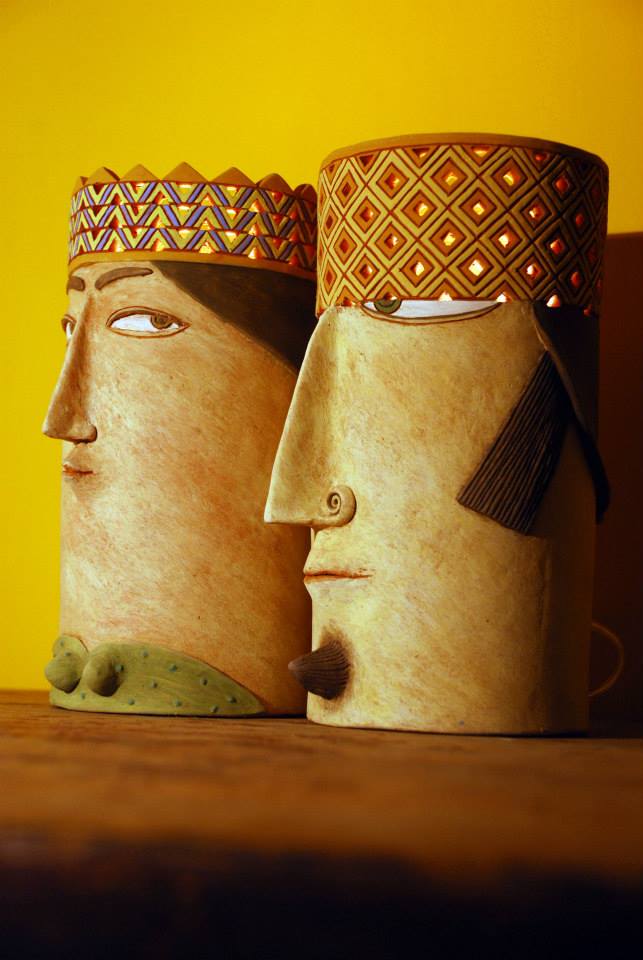
“King and Queen” lamps by Nicola Tripodi of Arghillà l’arte delle terre
THE FORM AND DETAIL OF NICOLA TRIPODI
His forms capture the essence of characters and images. When I entered the shop, he was working on a lamp, one of his numerous stylized faces: simple lines, meticulous detail, ironic gestures. Nicola inherited his penchant for design from his mother, a sarta. She was the type of seamstress who sized up a client with a glance and went straight for her scissors. His father was a mechanic, who fixed caterpillars by day and would tinker with watch mechanisms by night.
The genius is in the detail, as they say. I wondered how many hours of intricate work went into one of his large pieces, such as the cylindrical presepe (nativity scene) on display in the store: the careful creation of the characters and their abodes, a string of sausage passed from one window to the next, the woman with fresh eggs, another with bread. And then there are the personalities taken from real life, such as Tony, a local legend who entertains with his drums on the streets of Reggio, and the incorporation of local architectural features, such as a bifora (double-arched) window reminiscent of those in the renaissance Palazzo Delfino in nearby Gerace.
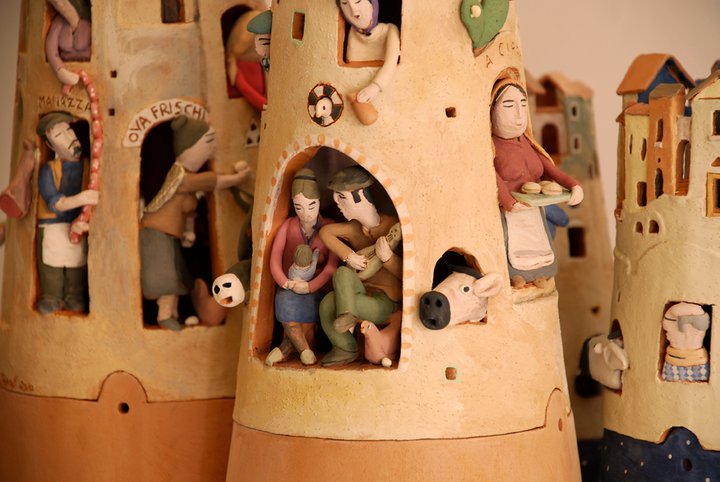
Nativity Scenes in terracotta by Arghillà l’arte delle terre
ARGHILLÀ L’ARTE DELLE TERRE: INSPIRED BY TRADITION
Each sculpture has a story, some more elaborate than others. Nicola Tripodi takes inspiration from traditions, often of lesser-known folk cultures, such as those of the province’s Greek-speaking area, from where his father’s family hails. He recalls that his relatives, who had “emigrated” to Reggio from Gallicianò, avoided using their native language in the big city and remembers instances of his Grandmother speaking her mother tongue only when she was scolding him. However, many customs and stories remained deeply rooted.
For example, the tale of the elopement of an Orthodox priest from Roccaforte with a woman from Bova was passed down over the centuries in the form of a nursery rhyme. The two towns are in the area grecanica or Greek zone in the Province of Reggio Calabria. In the dialetto reggino (Reggio dialect), reference is still made to U previti i Roccaforti (the Priest of Roccaforte) to describe an elopement, and Nicola fashioned a charming sculpture of the lovers escaping on a donkey, as inspired by the story.
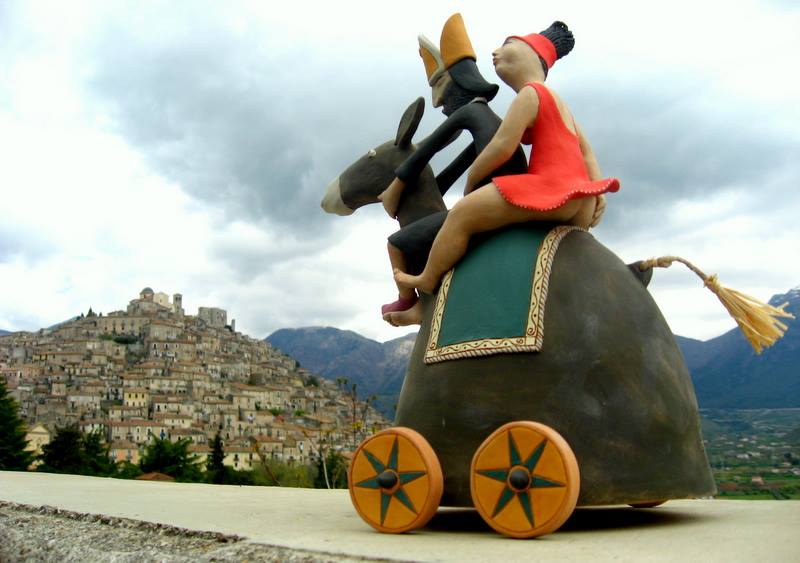
“U previti i Roccaforti” – The Priest of Roccaforte, terracotta sculpture by Arghillà l’arte delle terre
Another homage to the Greek-speaking area is the container Prandèghete (Newlyweds), which recalls decorative woodcarvings of everyday objects, such as those a shepherd would have made for his betrothed.
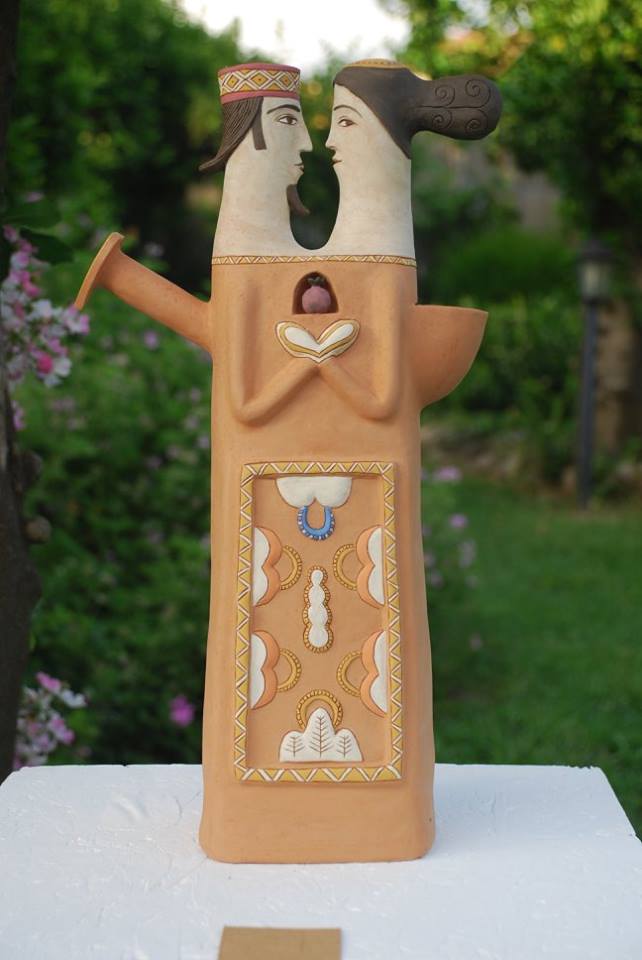
“Prandèghete” container in terracotta by Nicola Tripodi of Arghillà l’arte delle terre
Patterns in Nicola’s work may be inspired by traditional weaving, such as textiles made from fibers of the Scotch broom, or by local symbols, such as the Mediterranean fish in this bearded mask.
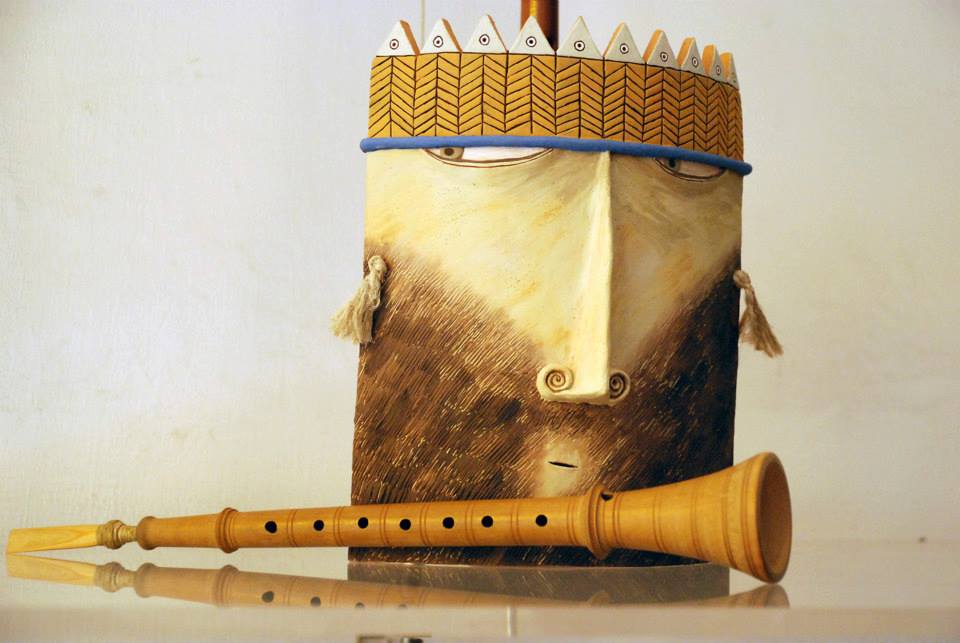
Bearded mask with fish detail and pictured with a ciarameddaru (shawm), Arghillà l’arte delle terre
ARGHILLÀ L’ARTE DELLE TERRE: INSPIRED BY PROVERBS (PROVERBI CALABRESI)
Descriptive sayings in Calabrian dialect have prompted the creation of numerous Arghillà l’arte delle terre sculptures. U sceccu ‘nto linzolu (the donkey in the sheet) is a favorite image of mine. While the winsome creature appears to slumber, it is actually only pretending to sleep. The proverb refers to a sly individual who avoids certain situations by feigning innocence.
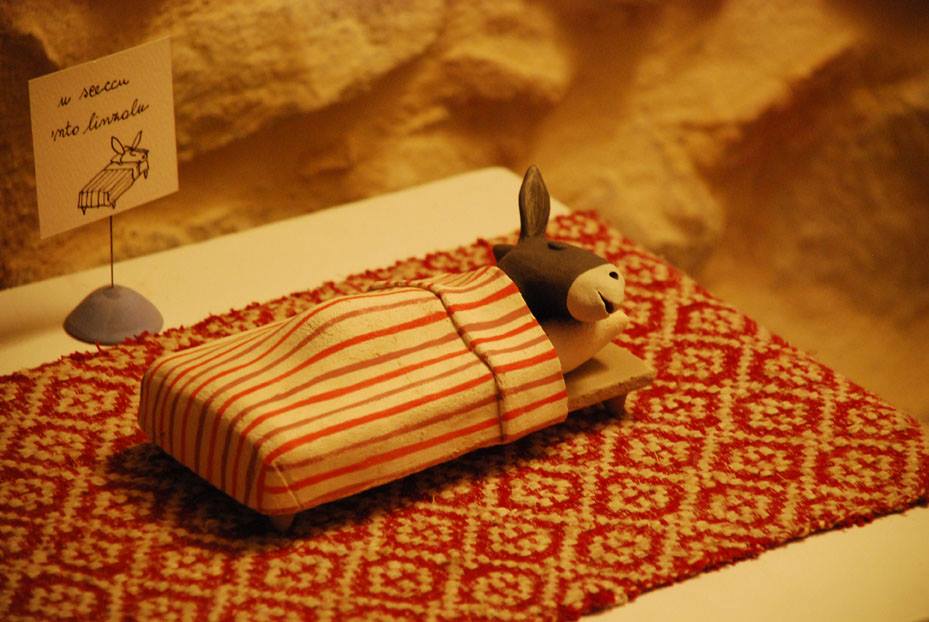
“U sceccu ‘nto linzolu” by Nicola Tripodi of Arghillà l’arte delle terre
Another saying that focuses on the donkey is said of the gullible individual, who believes in U sceccu chi vola (the donkey that flies).
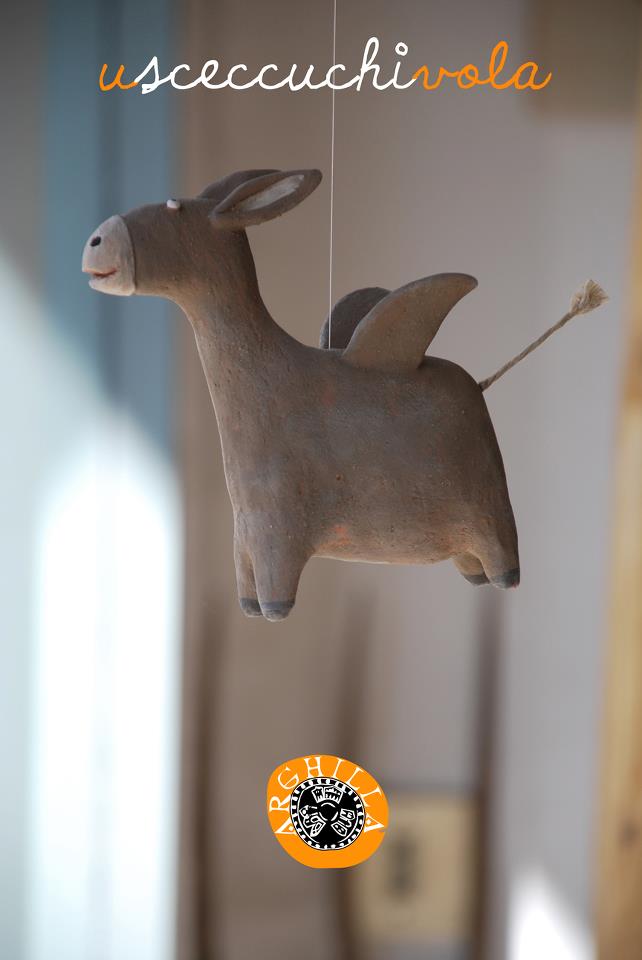
“U sceccu chi vola” in terracotta by Nicola Tripodi of Arghillà l’arte delle terre
A whistle in the form of a smaller fish in the mouth of a larger one illustrates a proverb from the area of Gioia Tauro: Amaru u picciulu chi vaci ‘nto grandi or bitterness for the poor, humble person who confronts the wealthy and arrogant. Life is perilous for the disadvantaged in the face of the powerful.
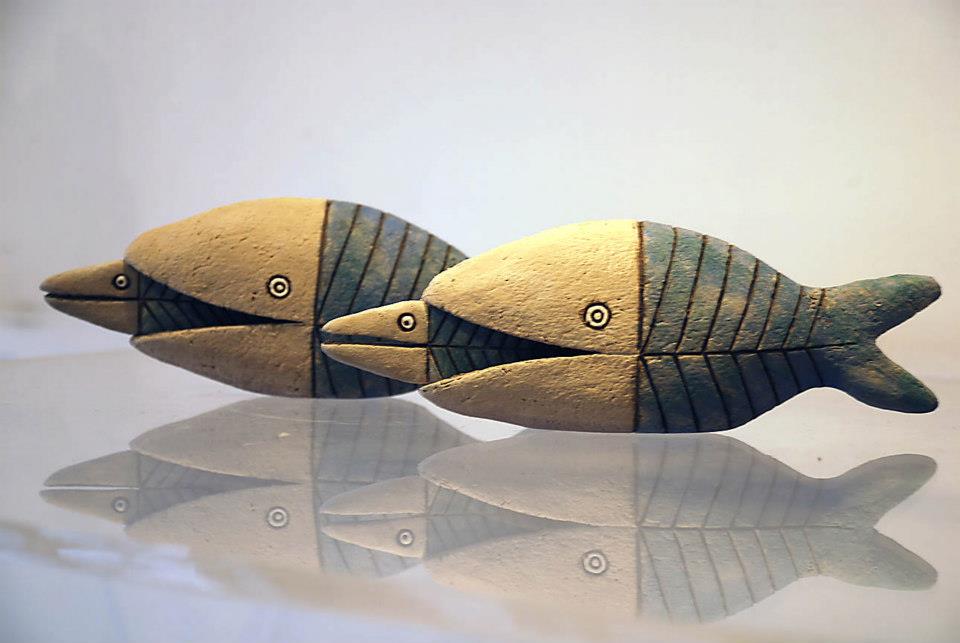
Fish Whistles “Amaru u picciulu chi vaci ‘nto grandi” in terracotta by ARGHILLÀ l’arte della terre
Another adage makes reference to the sheepskin cradle that hung from the ceiling over the parent’s bed. With a little push, the rocker would swing back and forth. The expression Aannaca u Pecuruor or rock the sheep, means to do something useless or superfluous, as once the cradle is pushed, it moves back and forth for a long time without need for a further nudge.
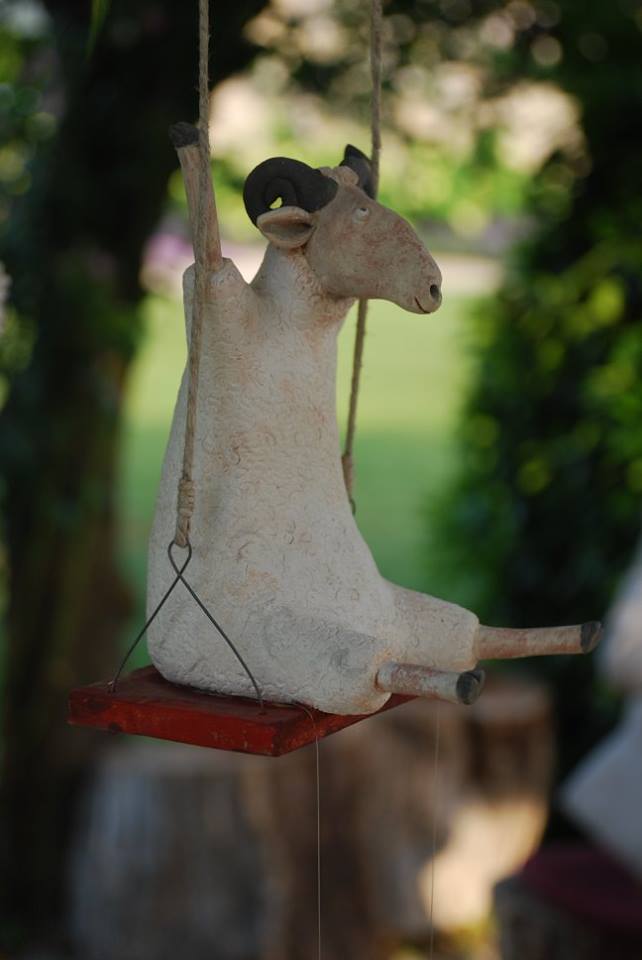
“Aannaca u Pecuru” by Nicola Tripodi of Arghillà l’arte delle terre
THE TERRACOTTA OF ARGHILLÀ L’ARTE DELLE TERRE
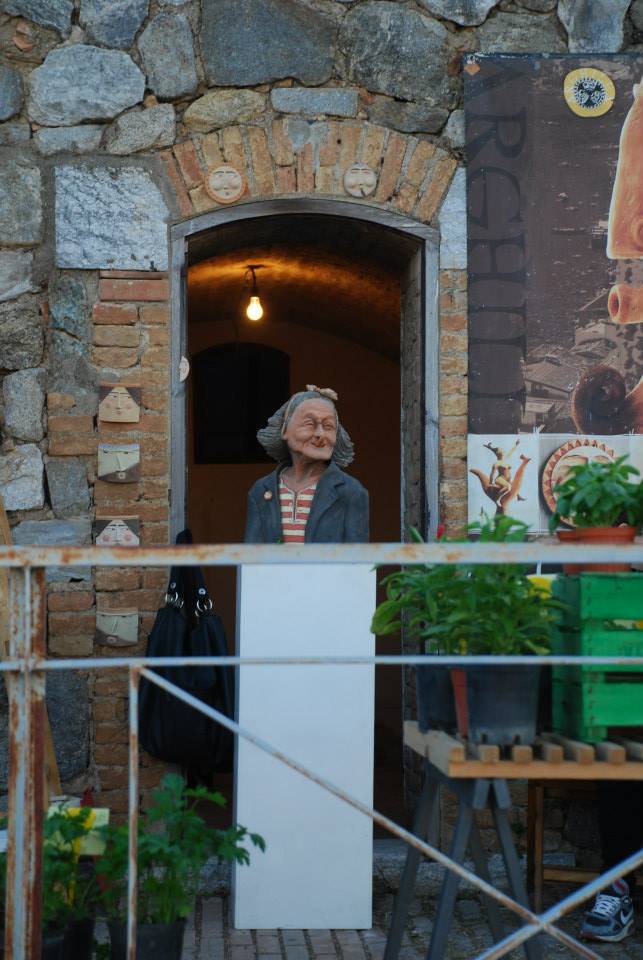
“Maria Ciaciola” in terracotta by Nicola Tripodi. She was a devil of a woman, a well-known “personality” in Reggio Calabria.
Arghillà l’arte delle terre fashions candelabras, containers, whistles, lamps, places (such as Pentedattilo and the Strait of Messina), masks, characters, nativity scenes and theaters in terracotta. Each object is sculpted and decorated by hand, thus each piece is a unique work of art. The creations are both mythical and real, often hearkening back to a time when objects themselves were endowed with spirits.
Nicola Tripodi molds these memories and traditions into contemporary forms in a delightful way. Seeing a sheep rocking back and forth on a swing can’t help but bring a smile to your face. The scandal of a priest, albeit Orthodox, running away with a woman in the village, has proved to be timeless. And making a connection with familiar people, customs and places transforms a celebration of Christmas into a celebration of a culture and an object lovingly left out on display all year long.
Photos courtesy of Nicola Tripodi and Arghillà l’arte delle terre. If you can’t make it to Arghillà l’arte delle terre in person at Via Sbarre Centrali, 249 in Reggio di Calabria 89132 (telephone +39 329 342 9115), visit the ARGHILLÀ l’arte delle terre Facebook page and website.
Check out the itineraries of my CALABRIA TOURS!
Interested in other contemporary artists in Calabria? On this blog, read about Nik Spatari in MuSaBa: Not Just a Museum, Textile Artist Domenico Caruso, Enzo Ferraro and the Ceramics of Seminara and Salvatore Tonnara in An Artist in Amantea. And for an in-depth look at the beautiful land in the toe of the boot, check out Calabria: The Other Italy, my non-fiction book about daily life, history, culture, art, food and society in this fascinating southern Italian region. It’s available in paperback and e-book versions.
“Like” Calabria: The Other Italy’s Facebook page and follow me on Karen’s Instagram and Karen’s Twitter for more beautiful pictures and information.
Sign up below to receive the next blog post directly to your email for free.

Comments 20
These sculptures are really great – they are both original and fun to look at! I’ve enjoyed them very much. Thanks for sharing.
Author
Absolutely, it’s a pleasure.
These pieces are wonderful! We plan to go to this region of Italy and when we are there we will certainly look for his shop.
Author
You’ve had such an exciting year of travels, Deb. On to Calabria!
Wow, these pieces are exceptionally beautiful. Watching him at work must be a real treat!!
Author
Yes, going to the source always brings the best insight to an artist’s work.
How gorgeous! I absolutely love these fabulous works of art. Thanks so much for sharing.
Author
Glad you enjoyed Arghillà’s beautiful pieces. From what I understand there’s a store in Ostuni that carries his work. He has a mask with a stylized detail of trulli.
What a talented man! Love the statues he made based on proverbs of the region. Truly unique.
Author
And so clever!
Love these sculptures.
Author
Me too, they have so much personality, they’re a joy to look at.
Absolutely taken with how the artist transforms traditional sayings into three-dimensional work. Thank you for this feature. I’m looking forward to exploring more of his work.
Author
Yes, it’s as if his work emanates directly from his culture. Glad you like it!
We have just returned from Ostuni in Puglia, where we bought two vessels by Nicola, we were told one is Ulysses and the other a traditional fisher woman. They are so beautifully made and I love to look at them everyday, wondering who made them. So your article was a fascinating read. Now we must visit Calabria and the studio. Thank you.
Author
Glad you found my blog! His pieces are wonderful, and as you say, the joy doesn’t diminish with time. Thank you for your comment.
Me encantó. Hoy, una amiga me hizo descubrir este lugar. Seguí buscando y llegué aquí. ¡Una maravilla! Gracias.
Author
Glad you enjoyed it. The artist’s work is truly captivating.
Bellísimo trabajo! En cuanto sea posible viajar lo haré! Todo se ha retrasado por las circunstancias, pero ya queda poco. He ahorrado para poder comprar un presepio. Espectaculares! Que trabajo ! Magnificos
Author
His work is truly special. Hopefully, you will be able to see it in person soon and even have a piece in your own home!